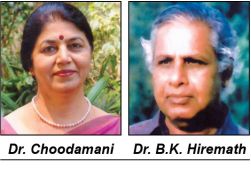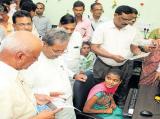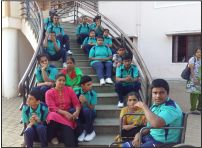
Prof. T.V. Venkatachala Sastry is an authority on ancient Kannada and Sanskrit classical texts. Speaking about the waning interest in this area of study, he tells DEEPA GANESH that we must be open to multiple interpretations of the text
It would well be a high pedestal if the acclaimed grammarian, lexicographer, Sanskrit and Halegannada scholar T.V. Venkatachala Sastry (TVV) sat on his achievements. But, on that cloudy morning in Mysore, the 83-year-old scholar was waiting at his gate. “You had to come all the way here, excuse me, I could not make it more convenient for you,” he said, with genuine concern. With over hundred books to his authorship, TVV is an authority on prosody, pre-modern classical texts, aesthetics, languages, literary criticism and more. He served the University of Mysore for several decades, and was later the director of Kuvempu Kannada Adhyayana Samsthe — the outcome of his erudition and vision has been huge. He has been guru to several generations of Indian students, and also to foreign scholars like Prof. Laurie Honke (who famously said to TVV: ‘You are Panini to me’), Prof. Showman, Prof. Karl Johanssen, and Prof. Stefan Anacker. Also teacher to the renowned Indologist, Prof. Sheldon Pollock, who attributes the idea of his book, “The Language of the Gods in the World of Men” to “the greatest living scholar in the field of old Kannada, T.V. Venkatachala Sastry”.

We settle down in his modest study, packed with books from all sides. On his bed by the window, are books that people have sent him, manuscripts, reading material etc. Lean that he is, TVV tucks in comfortably. The phone rings. It is a student who needs help with historical data. Yet again the phone rings, and this time in Telugu he tells the caller: “Of what use are these controversies? Chaduvukopora… Go to your studies, and I will also continues with mine.” In his home library of over 15,000 books, TVV knows exactly the location of each book. With undiminished energy after a conversation that ran into several hours, he explains his collection. “You must come again, I will keep some books for you,” he says with a rare generosity. The doors of his house constantly kept open for students, scholars, researchers and friends, TVV is so eager to give and share that 21st century ideas like “creative commons” seem outdated. For him, it is a way of life. Issues like intellectual property rights are hardly a matter of concern. Hence, if you discuss the global publishing industry, its politics and economics, you find that it lies outside his worldview. All that matters to him is the pursuit of knowledge.
Excerpts from the interview.
One often hears that soon there will be no one studying the classical texts in India, and the western world will be custodians of Indian classical studies. How do you react to this?
It is hard to give a yes or no answer. I don’t think that is expected of me either. Steadily, as someone who has been associated with the University, one see the dearth of students for Indian classical studies. About five decades ago, almost every Indian University had a department of Indian classical studies. We are hardly left with any now. With the advent of modern technology, it has become difficult even for departments of philosophy, science and literature to survive. Sanskrit and Halegannada became unpopular with students rather early.
We have had a continued relationship with Western scholars. They came from Germany, France, Finland, America… and worked extensively in India. For instance, Sir Monier Williams who studied, documented and taught Asian languages, wrote “An Elementary Grammar of the Sanskrit Language” (1846), compiled a Sanskrit-English dictionary (1899), A.B. Kieth wrote “The Sanskrit Drama” (1923), Weber’s “The Religion of India” (1916), F. Edgerton’s “Studies in the Veda” (1915), E.V. Arnold’s “Vedic metre in its historical development” (1905), Max Mueler’s “Sacred Books of the East” (1879-1910) and several others are early works by Westerners in the field of classical studies. There was rich literature available here and scholars have always been interested in studying it. Even back then, a lot was said about how they came with religious interest. It may be true, but it is not entirely true. They were genuinely attracted to languages, history and culture and worked assiduously. Karnataka has 25,000 to 30,000 inscriptions. Epigraphica Indica, the first volume of which was edited by James Burgess (1888) is the most competent. The later versions are just photographs of these inscriptions with no analysis whatsoever.
Their rigour was similar to that of our good old Pandits, who lived and breathed the subjects of their interest. The old school western scholars were also similar; however, you still find that this is a tradition continuing in their part of the world. Look how the outlook of our universities has changed so completely! They want to give you what is easy and what brings in many. The bulk of our literary, cultural-historical practises, has gone on reducing. Even if there is one single student, it is the responsibility of the University to keep the department functioning. You should be able to convince people to take it. However, ironically, now Universities ask, “What is the use of such a study?” Once you start asking questions of “usefulness” linked to material benefits, pursuit of knowledge simply moves to the background.
Do you think the Nehruvian imagination of State is also responsible for this?
Well… perhaps. It was a language of development, of course different from how we speak of it today. Also, these factions of Right and Left, have done more harm than good to classical studies. We must remember that the path of the King is flanked by a right and a left, but neither is complete in itself. Everyone wants to read their ideologies into these texts. Society is not just what constitutes our imagination. In this tussle for upholding one view, we have lost pride in what belongs to us. An anti-Sanskrit campaign started when ideologies began to take over.
Having said this, I think classical studies will survive. It will be sad that it may soon disappear from our formal educational processes, but it will live on, like it has all these years. I from my end, have started conducting workshops all over Karnataka for various interest groups.
Do you think the study of Halegannada and Sanskrit would help contemporary thinking, including the study of literature?
The classical way of learning is of no use to the “productive” outlook, to get jobs in this world. Let me tell you a story. A friend of mine, a solid pandit, was trained in the traditional way. Because he had not gone through formal schooling, he ended up as a middle school teacher. He took it as a challenge and did SSLC to MA from the Banaras University and became a lecturer. Isn’t this sad? The government must nurture this kind of scholarship.
The best of students go to other streams, and what we are left with is a disinterested bunch. My friend, a professor of philosophy, told me that he lectured on the philosophy of death for two hours, and at the end of it, students went out of the classroom laughing and whistling!
In your own personal interactions with several western scholars, were there moments when you felt “this far and no further”? Did you feel the “insider” was essentially different from the “outsider”? The outsider had an omniscient view, but a tad reductionist?
Hangal Virupaksha Shastrigalu, in the course of a conversation, had apparently mentioned to DVG that Westerners had done a lot of work. And DVG had remarked in a loaded statement: “Houdappa, they have. But with their mind.” (TVV laughs)
That’s exactly what they are saying about Sheldon Pollock too…
Is this great tradition of knowledge any single man’s property? It is for all. You have a problem with Pollock’s views? Let’s have an academic debate. Truth doesn’t change with somebody’s reading of it. I don’t understand this anxiety of representation!
Sheldon Pollock maybe alien to Indian culture and society. But the fact that he has spent four or more decades of his life studying all this, his readings will certainly not be grossly off the mark. Think of this – he could have chosen to study American literature which is closer to his culture. Why did he make this choice? He has been studying Sanskrit since he was 18. The respect he has, his passion, the depth and engagement, it is special. If you have to read old Kannada texts, you have to Shabdamani Darpana, which is no easy nut to crack. Pollock reads it. He comes back with doubts, and then when you give him an answer, he will tell you: “But this is what D.L. Narashimhachar has said…” Always thorough in his research.
Now listen to this. Kuvempu used to tell us in class that for us goddess Lakshmi comes with a whole emotional world of meanings, and therefore she means to us more than what she signifies. But for a Westerner, at best, she will be goddess of wealth. We recognise that difference. By virtue of being insider what is possible for you may not be exactly possible for them. But their research is also first hand. I personally feel that it is a great service that they have brought global attention to our ancient texts.
Having said this, let’s not even take away the merit of a discussion or of differences. Once, G.S. Shivarudrappa and I had a difference in a seminar about interpreting a verse from the Bhagavadgita. Should that take away our respect for each other? B.M. Shrikantaiah had once remarked that Halegannada poetry is kagga, old-fashioned and of little significance. Does that mean he had no respect for it? There are several instances to prove that he valued it immensely. I don’t understand this raising cudgel for everything.
I’m sure there have been discussions and disagreements between scholars in the past. Also inter-cultural. Can you recall some of those exchanges?
There have been famous exchanges, ones that have been documented. V. Sitaramaiah and R.V. Jagirdar (Sriranga), K. Krishnamurthy and Raganantha Sharma, Masti and Kuvempu, There are several others, academic and honest. That was the spirit of those times. The kind of teachers we had, and the writers of those times…. remarkable people who nurtured youngsters.
At the Shivagange Sahitya Sammelana for which Ram. Shri. Mugali was president, Masti had come. I had written a couple of essays for his journal Jeevana, so I went and introduced myself. He drew me into an embrace and said: “Chinnadanta baravanige. Golden writing…” There was nothing great in my writing, but it was their way of encouraging. Such generosity. Masti was so great a man that he apologized to Tirumalamba saying his observations on her writing were faulty. There was an intellectual atmosphere. Today, politics is dangerously ruling our cultural world.
Sediyapu Krishna Bhatta was an outstanding chandassu (metre) expert and a vedic scholar. S.D. Velankar had read all the Prakrit and Sanskrit texts. He had read so much more than Sediyapu. When he presented his views, Sediyapu didn’t take offence. Isn’t that a growth in pursuit of knowledge?
Let me tell you of A. Venkatasubbiah. He was a wonderful scholar. He was a master of vedic studies and Panchatantra. He had a doctorate from a German University in 1910. He wrote a 650-page book on the Veda. During the period even Western scholars were majorly into research. Venkatasubbaiah who had read all their works went on record to say – “Their estimate of several things are wrong because of cultural gap. I will revise the work of these German and French scholars.” In reply, one of them wrote, “Venkatasubbaiah is a great scholar but is not aware of recent research.” Isn’t this an ongoing process in the pursuit of knowledge?
I remember once Pollock asked me a question related to the works of Rice and Kittel. He had disagreements with their findings. He could have easily said, “What does this Venkatachala Sastry know? Kittel is the greatest afterall!” But that is anti-academic culture.
We have lost the tradition of Pandits. It has been replaced by professors. What is your reading of this situation?
The Pandits were unshakeable scholars. They had complete hold over the texts. They could extempore quote hundreds of poems, they could tell you the source of the words, their meaning, grammar… etc. University trained professors are aware of the modern tools of criticism, but their scholarship is limited. Also, the passion and commitment of the pandits cannot match that of professors. It is indeed a loss. In fact, DVG and Ti.Nam. Shrikantaiah have discussed this issue.
What is the difference between Indian and Western students?
It is very different, yet what I say are not generalisations. I have had fine students in the past who have become reputed scholars. Now, our students are not interested in the foundation. They are always trying to see how they can fit their ideologies into it. I always tell them to enjoy reading poetry for the sheer experience of finer feelings. Once that is done, you can start analysing and exploring other things. They are not prepared to enter the gateway of classical literature. They have lost patience, interest, engagement and the tools.
The West is interested in research, and wants to find new dimensions. They don’t get satisfied easily and work with perseverance and patience. Also, there is an academic system that is interested in the work of these scholars. They ask them questions, and engage with their work. There is a world that is watching them with interest. Here, even if I put out a great work, I am not sure if another scholar working in the same area as I do, will even read it. That makes a huge difference to your outlook.
You must understand one more thing, you get huge honours easily now. Social justice is fore-grounded and talent takes a backseat. Neralige sanmana madovaaga, akruti beke (when they felicitate shadows do you really need the real persona?)? Nevertheless, passion and interest needs no justification.
U.V. Swaminath Iyer, the Tamil scholar, writing about Malur Ranaganathachar who taught Sanskrit at the Presidency College says, “his head was constantly buried in some book or the other”. M.S. Puttanna writes about Triyambak Shastri: “He was always reading or writing. In case he felt drowsy in the afternoon, he would sleep over his book, wake up and start reading.” Ralapalli, our teacher, was an outstanding scholar. He would say, “I am slightly doubtful of this. I have asked D.L. Narasimhachar to help me with this.” Chidananda Murthy, at his age, calls me frequently to discuss something or the other. Learning is not easy. It is upasane. I feel thrilled when I read of such things. It is hard to find such people now. They all believed in the power of the text. Tell me, will Bhagavadgite get burnt if you burn it…?
You are quintessentially a traditional scholar who is not anxious about other readings of our texts…
Let me clarify this. I am a traditional scholar who has immense faith in the kind of learning that was imparted to me. We have a tradition and I believe in its values and respect it. I am also aware of its weaknesses. In a sense, I am also a moderner and in many ways I subscribe to some aspects of modernity. For instance, the liberal outlook that came with it. I stand in this new world, and would like to envision the ever expanding meanings of the old world order. I will not impose my beliefs on it. I adhere to the text, and am interested in its interpretation. No political ideology or country stamp will take me away from my commitment to the text. I will stand by what I find correct. If Pollock or whoever makes a mistake I will tell them my views. Since I respect scholarship, I respect Pollock’s dedication and good work too.
I want to quote Kavirajamarga. In a verse, Nrupatunga raises this question: “What is kasavara (gold)?” If you can accept another’s thoughts, another’s religion with antahkarana (feeling), that is gold. Else, he says, kasa (dirt) and kasavara (gold) are the same.
Corrections & Clarifications:
This report has been edited for factual errors.
source: http://www.thehindu.com / The Hindu / Home> Features> Friday Review / by Deepa Ganesh / Bengaluru – March 17th, 2016










